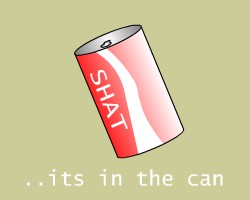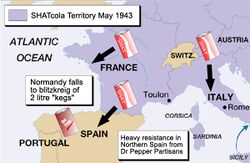Cola Wars

Known as one of the most divisive wars in recent history, the Cola Wars are a great shadow cast upon the late 20th and early 21st centuries. They were fought between soft drinks Coca-Cola and Pepsi; it is not the wrath of these individual forces that most countries fear, but rather their combined wrath. If Pepsi and Coke were to merge in a worst-case scenario, it would create an unholy, unstoppable force that would outmatch God Himself.
The war raged on from the 1970s to mid-2000s, showing some signs of abating recently. The Cola Wars have become so well-known in popular culture, that they have spawned two movies, three video games, 18 books, and a hit Megadeth single entitled "Cola Warlords... Countdown to Do the Pepsi Carnage".
Episode I: The Phosphorous Menace[edit]
The devastating Cola Wars began in 1975 when Pepsi issued an ultimatum (which has since come to be known as the "Pepsi Challenge") to its long-standing rival, Coke. This long, wordy, and above all rude missive, which ended with the phrase "Up yours with carbonation!" provoked a swift response.
Quickly Coke launched a youth blitzkrieg, sending millions of singing young people onto the hillsides of America in a bloody offensive that decimated the ranks of Pepsi People. While Dr. Pepper partisans ranged through the land, picking off vulnerable Pepsi demographics, 7-Up maintained its Switzerland-like Un-Cola neutrality (a stance that would eventually be its own undoing). After that, Pepsi attacked the Coke base and 100,000 pounds of Coke was drained into the Atlanta River.
Episode IV: A New Soda-Jerk-Hose[edit]
Soon Pepsi was in full retreat, its market share plummeting and its advertising in tatters. With its rival firmly beneath its refreshingly-hobnailed bootheel, Coca-Cola held sway on the battlefield for many years. Only Coke's ill-fated assault on RC territory kept it from sweeping the planet entirely.
The 1980s saw the beginning of a new phase in the Cola Wars. A new crop of Pepsi generals devised a brilliant plan centered around setting the hair of various top-shelf celebrites on fire. Pop singer Michael Jackson was the first to be launched into Coke territory with his hair on fire. An exchange of fiery-headed celebrites quickly developed, with such luminaries as Telly Savalas, Bill Cosby, Max Headroom, the Coca-Cola Duck, and Spuds McKenzie sacrificing their follicles as the bloody war between Coke and Pepsi reignited.
A stalemate quickly ensued as fiery-headed celebrities duked it out on the advertising battlefield. An entire platoon of Coke-sponsoring celebrities was bloodily mowed down by a (literally) flame-haired Gloria Estefan. Truly, the carnage was just awful. Truly. Which side truly "started the fire" was disputed among scholars during the 1988 Geneva Accords. The debate apparently ended when Billy Joel couldn't take "rock 'n' roller Cola Wars" anymore and both parties called it off.
Episode V: The Empire Sprites Back[edit]
By the middle of the '80s, despite thousands of lives and millions of advertising dollars spent, neither side had gained much ground. Frustration at Coke lead to a bold, ultimately disastrous plan that would threaten not only the company but the very fabric of time and space itself. It was called: New Coke. In the annals of the Cola Wars there is no episode more painful, more horrifying than the harakiri launch of New Coke. To this day, Cola War veterans shudder at the memory of entire Coke phalanxes being wiped out in the New Coke debacle.
Episode VI: The Campus Front[edit]
By the turn of the millennium, the Cola Wars had flared on a whole new front: college campuses. It all started when a group of RC Cola partisans from the New York University started their Killer Coke campaign. Their objections to Coke were simple — that it kills. No one has been able to fully support this hypothesis (in fact, I've seen people drink six cans of Coke at a time with no ill effects); however, there were reports that some people had, in fact, been killed by Coke. Due to pressure by this group of students, the University decided to ban Coca-Cola products indefinitely beginning December 9, 2005 (joining the University of Michigan, where students succeeded in getting Coke products banned due to allegations that several slim-shady Detroit camera dealers drank Coke). Killer Coke campaigns also existed at many other universities, but did not achieve a Coke ban (possibly due to the relative weakness of RC Cola positions at these universities).
This anti-Coke backlash on college campuses had immense repercussions on the Cola Wars. First of all, though the anti-Coke offensive was largely supported by RC Cola partisans, Pepsi benefited greatly from the offensives as well because of their alliance with the BBTO (Blue Beverage Treaty Organization, consisting of Pepsi and RC Cola). The RBTO (Red Beverage Treaty Organization, consisting of Coke and Dr. Pepper) suffered large losses due to the campus backlash, and had to resort to guerrilla campaigns in areas occupied by BBTO forces. 7-Up continued to maintain its Un-Cola neutrality in this new front, and this time it paid off; their positions were untouched by these events, and even saw small gains due to the retreat of Coke forces at several campuses. Overall, the war has become a Red vs. Blue war, much like the recent Presidential elections (ironically, with a large number of Republicans backing the RBTO and Democrats backing the BBTO) — and this war is far from over.
However, in April 2006, Coca-Cola launched a major offense to retake the University of Michigan campus. As a result of this, territories conquered by RC Cola and Pepsi forces have been liberated and the ban of Coke has been rendered null and void. Diet Coke and Coke Zero played a huge role in the campaign, as several fraternities and sororities joined in on the action and rioted in support of Coke and in opposition to the "foul taste" of Diet Pepsi. This proved to be the RC partisans' undoing, as at the moment they are solely confined to a small section of East Quad.
